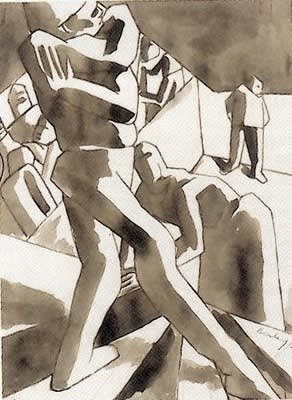David Bomberg 1890-1957
Stairway drawing no. 3, 1919
Pen, brush and black ink
26 x 19.5 cms
10 3/16 x 7 10/16 ins
10 3/16 x 7 10/16 ins
370
Sold
Provenance: Mrs. P. Loftus Newly liberated by the ending of his lengthy exertions for his major World War 1 commission, 'Sappers at Work' (1918-19), in 1919 Bomberg worked on an...
Provenance:
Mrs. P. Loftus
Newly liberated by the ending of his lengthy exertions for his major World War 1 commission, 'Sappers at Work' (1918-19), in 1919 Bomberg worked on an extended series of small drawing, of which 'Stairway Drawing' is a typical example in size, form, composition and the centrality of the human figure.
Executed in pen and wash on thin paper, these drawings marked a decisive moment in Bomberg's development of a more solid, rounded and humane figuration after the linearity, angularity and flatness of so much of his wartime work.
Bomberg's first wife, Alice, recalled this fruitful sense of exhultation, following despatch of 'The Sappers' : 'almost before it was gone, David was at work on a set of small drawings - encouraged by the quality of the typing paper I was able to bring him from the office. One day I got home from the office and there wasn't anywhere to sit - chairs and tables and the throne even was covered with small drawings in various states, from finished works to wet sheets of painting waiting for the final application of gum arabic - which would produce a glazed finish.'
At the time Bomberg was finding it hard to sell his work and Alice recalls of these drawings: 'he sold many of them to friends at a pound each and we said they kept us in bread and butter for many months.'
So impressed was the critic Frank Rutter that he organised a show of these drawings at his newly opened Adelphi Gallery in 1919. There Bomberg's drawings attracted generous praise from Herbert Read, in one of the critic's earliest reviews: 'the ideas are always good . and the way he will explore all the possibilities of an idea in a series of drawings seems to indicate that his mind is of that objective, scientific sort that alone is capable of wonders. Mr Bomberg is possibly a great artist.'
On these drawings see Richard Cork, 'Bomberg', Yale 1987, pp.126-131
Mrs. P. Loftus
Newly liberated by the ending of his lengthy exertions for his major World War 1 commission, 'Sappers at Work' (1918-19), in 1919 Bomberg worked on an extended series of small drawing, of which 'Stairway Drawing' is a typical example in size, form, composition and the centrality of the human figure.
Executed in pen and wash on thin paper, these drawings marked a decisive moment in Bomberg's development of a more solid, rounded and humane figuration after the linearity, angularity and flatness of so much of his wartime work.
Bomberg's first wife, Alice, recalled this fruitful sense of exhultation, following despatch of 'The Sappers' : 'almost before it was gone, David was at work on a set of small drawings - encouraged by the quality of the typing paper I was able to bring him from the office. One day I got home from the office and there wasn't anywhere to sit - chairs and tables and the throne even was covered with small drawings in various states, from finished works to wet sheets of painting waiting for the final application of gum arabic - which would produce a glazed finish.'
At the time Bomberg was finding it hard to sell his work and Alice recalls of these drawings: 'he sold many of them to friends at a pound each and we said they kept us in bread and butter for many months.'
So impressed was the critic Frank Rutter that he organised a show of these drawings at his newly opened Adelphi Gallery in 1919. There Bomberg's drawings attracted generous praise from Herbert Read, in one of the critic's earliest reviews: 'the ideas are always good . and the way he will explore all the possibilities of an idea in a series of drawings seems to indicate that his mind is of that objective, scientific sort that alone is capable of wonders. Mr Bomberg is possibly a great artist.'
On these drawings see Richard Cork, 'Bomberg', Yale 1987, pp.126-131




